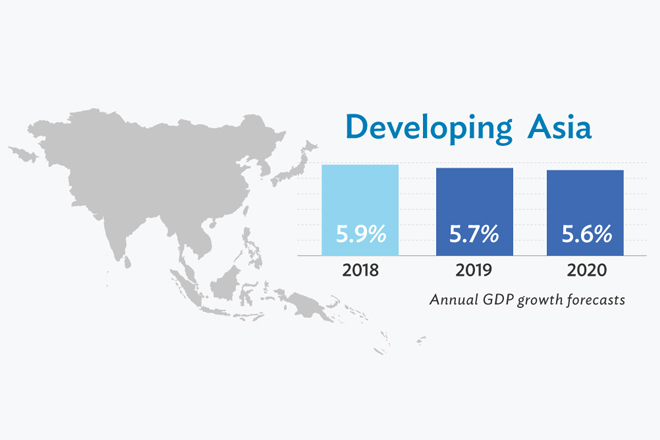Apr 03, 2019 (LBO) – Growth remains strong across most of developing Asia but is set to moderate this year and next year against the backdrop of slowing global demand and persistent trade tensions, according to a new Asian Development Bank (ADB) report.
The latest Asian Development Outlook (ADO) 2019, ADB’s flagship economic publication, forecasts that growth in the region will soften to 5.7% in 2019 and 5.6% in 2020.
Developing Asia’s growth in 2018 was 5.9%. Excluding the newly industrialized economies of Hong Kong, China; Republic of Korea; Singapore; and Taipei,China, developing Asia is forecast to expand 6.2% in 2019 and a slightly slower 6.1% in 2020. In 2018, growth was 6.4%.
“Growth overall remains solid with domestic consumption strong or expanding in most economies around the region. This is softening the impact of slowing exports,” said ADB Chief Economist Mr. Yasuyuki Sawada. “Uncertainty clouding the outlook remains elevated.”
Trade conflict between the United States (US) and the People’s Republic of China (PRC) is still the primary risk to the region’s economic outlook with protracted negotiations propelling further global trade uncertainty.
Other risks are a potentially rapid slowdown in advanced economies and the PRC, as well as financial volatility.
ADB forecasts slower combined growth in the US, the European Union (EU), and Japanese economies of 1.9% this year and 1.6% in 2020 given tighter fiscal and monetary conditions in the US, the prospects of a disorderly United Kingdom exit from the EU, and the US–PRC trade conflict.
In the PRC, structural changes in the economy away from industry and towards services and financial tightening as the government seeks to control financial risks will likely see economic growth moderate to 6.3% in 2019 and 6.1% in 2020 from 6.6% in 2018. Slower growth is to be expected as the PRC economy matures.
By contrast, stronger consumption will see growth in India tick up from 7.0% in 2018 to 7.2% in 2019 and 7.3% in 2020 with lower policy interest rates and income support to farmers boosting domestic demand.
South Asia overall will outperform other subregions and is forecast to expand 6.8% this year and 6.9% next year.
Growth will also rebound in the Pacific from 0.9% in 2018 to 3.5% in 2019 as liquefied natural gas production in Papua New Guinea, the subregion’s largest economy, returns to full capacity following an earthquake in 2018. Growth is expected to be 3.2% in 2020.
Lower oil prices, alongside slower growth in the Russian Federation will weigh on economies in Central Asia.
buy lasix online buy lasix online no prescription
Growth in the subregion is forecast to slow to 4.2% for this year and in 2020.
Inflation remains low. Stable food and fuel prices mean headline inflation will be steady at 2.5% in both 2019 and 2020, the report says.
While Asia’s emerging market currencies improved somewhat in late 2018, research prepared for the ADO noted that exchange rate volatility can be problematic, particularly for countries that rely on US dollar-denominated debt.
Suitable monetary and macroprudential policies, regional policy dialogue, and deeper domestic capital markets can mitigate the impact from tighter external funding conditions.
Slower global demand pulls down developing Asia’s growth prospects: ADB

